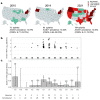Apis mellifera Solinvivirus-1, a Novel Honey Bee Virus That Remained Undetected for over a Decade, Is Widespread in the USA
- PMID: 37515283
- PMCID: PMC10384192
- DOI: 10.3390/v15071597
Apis mellifera Solinvivirus-1, a Novel Honey Bee Virus That Remained Undetected for over a Decade, Is Widespread in the USA
Abstract
A metagenomic analysis of the virome of honey bees (Apis mellifera) from an apiary with high rates of unexplained colony losses identified a novel RNA virus. The virus, which was named Apis mellifera solinvivirus 1 (AmSV1), contains a 10.6 kb positive-strand genomic RNA with a single ORF coding for a polyprotein with the protease, helicase, and RNA-dependent RNA polymerase domains, as well as a single jelly-roll structural protein domain, showing highest similarity with viruses in the family Solinviviridae. The injection of honey bee pupae with AmSV1 preparation showed an increase in virus titer and the accumulation of the negative-strand of AmSV1 RNA 3 days after injection, indicating the replication of AmSV1. In the infected worker bees, AmSV1 was present in heads, thoraxes, and abdomens, indicating that this virus causes systemic infection. An analysis of the geographic and historic distribution of AmSV1, using over 900 apiary samples collected across the United States, showed AmSV1 presence since at least 2010. In the year 2021, AmSV1 was detected in 10.45% of apiaries (95%CI: 8.41-12.79%), mostly sampled in June and July in Northwestern and Northeastern United States. The diagnostic methods and information on the AmSV1 distribution will be used to investigate the connection of AmSV1 to honey bee colony losses.
Keywords: Apis mellifera; RNA virus; family Solinviviridae; honey bee; honey bee colony losses; insect; pollination service.
Conflict of interest statement
The funders had no role in the design of the study; in the collection, analyses, or interpretation of data; in the writing of the manuscript; or in the decision to publish the results.
Figures





References
-
- Ellis J.D., Evans J.D., Pettis J. Colony losses, managed colony population decline, and Colony Collapse Disorder in the United States. J. Apic. Res. 2010;49:134–136. doi: 10.3896/IBRA.1.49.1.30. - DOI
-
- Traynor K.S., Rennich K., Forsgren E., Rose R., Pettis J., Kunkel G., Madella S., Evans J., Lopez D., vanEngelsdorp D. Multiyear survey targeting disease incidence in US honey bees. Apidologie. 2016;47:325–347. doi: 10.1007/s13592-016-0431-0. - DOI
Publication types
MeSH terms
Substances
LinkOut - more resources
Full Text Sources

